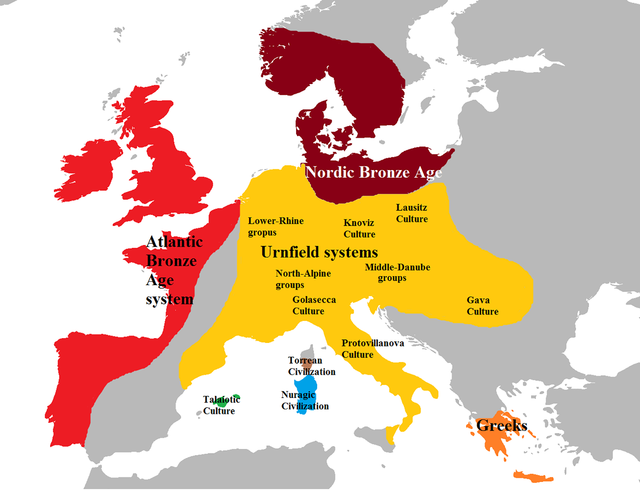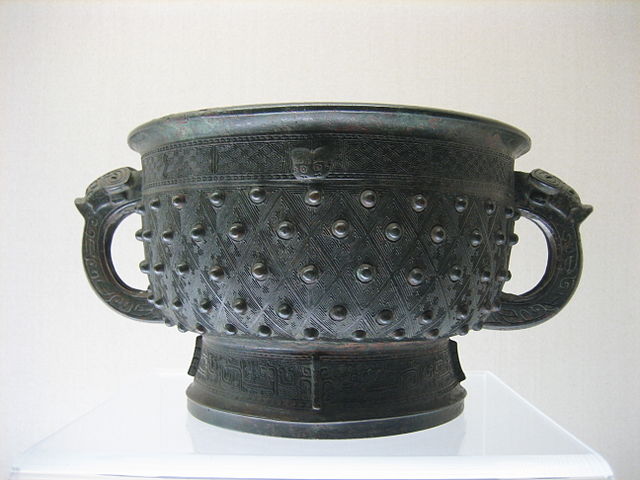Bronze Age
prehistoric period and age studied in archaeology, part of the Holocene Epoch From Wikipedia, the free encyclopedia
Remove ads
The Bronze Age is a period in human prehistory when people made tools from bronze, an alloy (mixture) of metals.[1]



Archaeologists think that people became more organised in the Bronze Age because making metal tools was difficult and needed certain skills. The people who had these new skills would have been important. The new metal tools were bought, sold, or traded across larger distances.
Writing was invented around the beginning of the Bronze Age in some areas. People soon began writing about events and administrative matters.
Remove ads
Timeline
The Copper Age began to develop into the Bronze Age when smiths learned that their copper became stronger if they added a little tin. By combining copper with tin (usually nine parts copper to one part tin), they created bronze. It was stronger than copper, so it made stronger tools. Bronze was better for cutting and chopping than wood or stone tools, and was easier to shape.
The Bronze Age did not happen at the same time everywhere, because different groups of people started making bronze at different times. In Western Europe, the Bronze Age lasted from about 2000 BC until 800 BC. In the Middle East, it started about a thousand years earlier. For example, bronze was first used in Mesopotamia around 3300 BC.[2][3]
Later, when iron tools spread, the Bronze Age ended and the Iron Age started. Iron replaced bronze partly because iron ore (rock that might contain iron) is much more common than tin ore.
Remove ads
Agriculture

By the Bronze Age, humans were farmers and wild food was no longer a main part of their diet.
Farming allows more people to live in an area than hunting and gathering can support. Crops can be stored for off-season use, or to sell or barter. There was enough food that some people could do things other than agriculture. This was a crucial factor in the rise of full-time armies.
Mesopotamian agriculture
The title "inventors of agriculture" might go to the Sumerians, starting around 5500 BC.
Sumerian agriculture allowed them to win battles and land. This made them early empire builders. Not long after, the Egyptians, farming in the fertile Nile valley, increased their population. There were now enough warriors to conquer more land, tripling the Sumerian empire in area.
In Sumer, barley was the primary crop; wheat, flax, dates, apples, plums, vegetables and grapes were grown as well. Mesopotamian agriculture was both supported and limited by flooding of the Tigris and Euphrates rivers. Floods came in late spring or early summer from snow melting from the Anatolian mountains.
Sheep, wolves, cows and goats were domesticated, kept mainly for meat, milk, butter and cheese. Ur, a large town that covered about 50 acres (20 hectares), kept 10,000 animals; 3,000 were slaughtered every year. The city's population of 6,000 included a labour force of 2,500, cultivated 3,000 acres (12 km²) of land. The labor force included storehouse recorders, work foremen, overseers, and harvest supervisors as well as laborers.
The land was plowed by teams of oxen pulling light unwheeled plows and grain was harvested with sickle. Wagons had solid wheels covered by leather tires kept in position by copper nails and were drawn by oxen. As many as four animals could pull a wagon at one time. The horse was domesticated in Ukraine around 4000 BC, and was in use by the Sumerians around 2000 BC.

Remove ads
Related pages
References
Wikiwand - on
Seamless Wikipedia browsing. On steroids.
Remove ads
